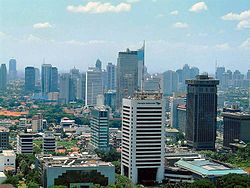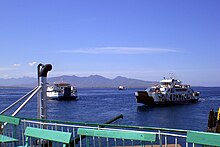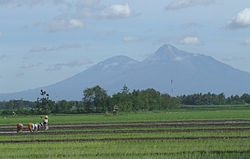Java (Indonesian: Jawa) is an island in Indonesia. The much smaller but still sizable island of Madura, off the coast of and covered as part of the region of East Java, is also included in this article.
Regions
[edit]
Wikivoyage divides the island into three groupings:
| Western Java (Greater Jakarta, Banten, Bogor Raya, Parahyangan, East Parahyangan, North Coast) One of the most densely populated regions on earth, including the massive urban sprawl of Jakarta and the university city of Bandung in the mountains. Still, there are extensive natural areas of impassable rainforest, as well as many active volcanoes and secluded beaches. |
| Central Java (Semarang Metropolitan Area, Banyumas, Jepara-Rembang, Kedu, Pekalongan, Surakarta, Yogyakarta Special Region) Charming Yogyakarta and significant ancient temples. |
| East Java (Surabaya Metropolitan Area, Madura, Ngawi, Northwest, Southern Mountainous, The Horseshoe) Indonesia's second city Surabaya and stunning volcanic scenery. |
Cities
[edit]
- 1 Jakarta — the chaotic, congested yet oddly fascinating Indonesian capital.
- 2 Bandung — a cool city in a valley between the mountains. Gastronomic adventurers and budget travelers can head here.
- 3 Bogor — the former summer capital, known for the world-class botanical gardens.
- 4 Cirebon — nicknamed the 'city of shrimps' at the Java Sea coast, with four sultan palaces.
- 5 Malang — a cool and cultured place in the mountains in the eastern end of Java.
- 6 Semarang — the capital of Central Java, an ancient seaport with preserved colonial legacies.
- 7 Solo — a centre of Javanese culture and history, a long rival of Yogyakarta.
- 8 Surabaya — capital of East Java: hidden charm with unique blend of Javanese, Madurese, and Chinese cultures.
- 9 Yogyakarta — a city that is a historical and current centre of Javanese culture and tradition.
Other destinations
[edit]- 1 Anyer — beautiful beach, gateway to Krakatoa volcano
- 2 Baluran National Park — savannah grasslands which will make you think you are in Africa
- 3 Bromo-Tengger-Semeru National Park — spectacular volcanic scenery, home of the Tenggerese
- 4 Borobudur — the largest ancient Buddhist temple, a serious contender for the world's eighth wonder
- 5 Madura — large, remote, arid island and off the beaten path for visitors
- 6 Mount Halimun Salak National Park — the best and most complete rainforest area in Java, near Bogor
- 7 Prambanan — ancient Hindu temple
- 8 Sukamade — turtles come to lay their eggs virtually every night of the year
- 9 Ujung Kulon National Park — a national park with unspoiled jungles, white sand beaches, corals and the last examples of the Javanese rhinoceros; need permit to enter
Understand
[edit]
Java is Indonesia's fifth-largest island, comprising only 7% of Indonesia's territory (127,569 km2 (49,255 sq mi)), but 65% of Indonesia's entire population (145 million people) fills the island. It is the world's most populous island, with a density of 940 people per km²! Java has a population larger than Russia's despite being over 130 times smaller than Russia in land area.
Indonesia's most important cities are on this island. Jakarta, the capital of Indonesia, is located on Java's northwest coast. Surabaya (the second largest city in Indonesia), is located in East Java. Bandung (the third most populous city in Indonesia), is the capital city of West Java province. Yogyakarta and Surakarta (Solo), although not large in population are very significant centres of culture, in southern central Java.
The island of Java has distinct cultural zones. In the west Sundanese, Betawi in Jakarta. Javanese, for most of Central and Eastern Java provinces with the Madurese at Madura Island. Smaller indigenous tribes include the Badui of the west and Tengger from the east.
This is a quite remarkable island with no less than 30 active volcanoes. Add to that a host of major national parks with lots to offer the visitor who appreciates outdoor attractions.
Talk
[edit]While Indonesian (Bahasa Indonesia) is the lingua franca understood by almost everyone, the majority of Java's population also speak Javanese, a related but mutually unintelligible language. As the largest single language in Indonesia, Javanese influence on Indonesian has been quite significant, in Central and East Java local pronunciation changes — changes include a turning into o, so eg. Surabaya becomes Suroboyo.
Other significant local languages include Sundanese, spoken in West Java, Betawi in Jakarta and Madurese, spoken on and around the island of Madura.
At the border of the West Java and Central Java provinces, the people use a combination of Sundanese and Javanese which confuses people who speak only Sundanese or Javanese.
Get in
[edit]By plane
[edit]The largest airport of Java (and the entire country) by far is Soekarno-Hatta International Airport (CGK IATA), serving the Greater Jakarta area. Most international airlines fly to this airport. An increasing number of international carriers also fly to Surabaya in East Java, and to a lesser extent to Bandung, Semarang, Solo, and Yogyakarta. Flying to these secondary airports can be dramatically cheaper than connecting from Jakarta thanks to the role of low cost carriers from Malaysia and Singapore, so you might want to transit at one of these two countries before heading to Java. All of the mentioned airports are well-connected by domestic flights. Jakarta's secondary Halim Airport (HLP IATA), in East Jakarta, also has frequent flights from all major Indonesian cities.
By ferry
[edit]
There are two high-frequency ferry routes to Java, operated by ASDP. From the island of Sumatra in the west, ferries operate from Bakauheni in Lampung province to the port of Merak on Java (24 hours per day, multiple departures per hour). From the island of Bali in the east, ferries operate from Gilimanuk to the port of Ketapang in East Java (24 hours per day, two departures per hour).
Java is also part of the national PELNI passenger ferry network, with routes to and from all major Indonesian islands. PELNI ships call at the ports of Surabaya, Semarang, and Tanjung Priok port in North Jakarta.
Get around
[edit]Java's infrastructure is comprehensive in - it is possible (but not advisable to try) to cross the entire island by land in a single (long) day. However, the sheer density of population means that roads, buses and trains can get overcrowded if you're moving at the same time as everyone else.
By bus
[edit]The main form of long-distance transport, vast armadas of buses cross the island and connect every city and mountain hamlet. Using a bus is a good option since most cities in Java are connected to a toll road. The buses mostly run in the afternoon and/or night, can stop along the route and are generally cheaper than most low-cost air carriers. There are two types of buses, with aircon and without aircon; the fare of non-aircon is only about a third of using aircon. If you do take a bus, take one with aircon because drivers of such buses are known to be safer, as a general rule. For long trips, people tend to use a low-cost carrier, because it's much faster.
There are many luxury bus brands with many classes or different leg room, one example can be seen here[dead link].
There are also luxury double-decker bus services from Jakarta to several cities in Central Java. The lower deck is occupied with sleepers (bed seats) and the upper deck with reclining seats. Shoes must be taken off when using sleepers. Due to limited seats and high demand for a sleeper seat, booking in advance is needed.
By train
[edit]Java has the most comprehensive railway network in Indonesia, with trains connecting the capital city of Jakarta with most other cities and towns on the island. The executive class is available between capital cities of the province. Some routes also have priority class carriages for 28 passengers. Jakarta-Surabaya has a luxury class carriage with 18 reclining sleepers. Jakarta-Solo, Jakarta-Yogya, and Jakarta-Malang train route have a luxury class carriage with 26 sleepers seats.
The exclusive carriage (kereta wisata, literally, "tourist carriage") is a luxury passenger carriage that can be rented and attached to a regular train for a specific journey.
Ticket reservations can be made 90 days in advance up to 24 hours before departure. Online ticket reservations are available through PT Kereta Api's ticketing site[dead link] (Accessible only from Indonesia, VPN needed, Indonesian credit card required), several other online ticket agent websites (tiket.com, Bookaway) and convenience stores (e.g. Indomaret or Alfamart). You can choose your seats at Indomaret but not in Alfamart. You can also buy a ticket from a ticket agent's shop or the local post office in most cities in Indonesia. Either way, travellers get a printable voucher for the price of the ticket plus a Rp 7,500 administration fee. Indomaret and Alfamart usually will give discounts that cover the administration fee and sometimes give a free snack/drink as well.
The ticket can later be exchanged at one of the ticket counters or at some modern stations you can present your ticket on your phone without exchanging it first. Your name on the ticket must be the same as the spelling used on your identity card or you will be charged double.
All transportation modes in Indonesia are not quite friendly to the needs of disabled people. In October 2014, PT Kereta Api released a breakthrough with disability wagon(s) which has a wide door, ample space for wheelchair and toilet for disabled persons. No additional charge to use disability wagon. It is applied in new route through the north of Java double tracks, Jakarta-Surabaya-Malang vice versa and gradually will be implemented to all executive long routes.
By road
[edit]Java's toll roads or Trans Jawa are built nearly to Western standards, with dual grade-separated lanes in both directions and elevated interchanges. Tolls are quite affordable, roughly Rp1,000 per km for 900 km (560 mi), stretching from Merak to Surabaya. However, signage is often lacking and driving habits are atrocious, so it's very wise to pay a little extra and get a car with driver instead of attempting to drive yourself.
By plane
[edit]Flying is a good option for travelling larger distances in Java. The route from Jakarta in the west to Surabaya in the east is one of the busiest flight routes in the world. In addition, there are frequent flights from Jakarta (and Bandung) to other airports in Central and East Java, and e.g. between Yogyakarta and Surabaya. Apart from these trunk routes, there are smaller routes to more remote airports such as Pangandaran and Cilacap on the south coast, and the outlying islands of Karimunjawa, Madura, and Bawean.
See
[edit]
Java offers everything a somewhat adventurous traveler is looking for: two of the world's great ancient monuments, volcanoes (all 121 of them), major national parks, rainforests, tea and rice plantations, large cities, big waves and even savanna. The scenery in most parts of Java is spectacular and, while the island is overpopulated, there are still plenty of unspoiled places. Even though the beaches are not very appealing in Java and tides can be fatal especially in the south of Java, except for surfing in Banyuwangi, East Java. In nearby archipelagos like Pulau Seribu or Karimunjawa the traveler can find white sand beaches and coral islands.
Itineraries
[edit]- Great Post Road — one of the main roads of Java Island, that spans from its west coast at Anyer, to Panarukan at the east
- Gunung Semeru — a demanding trek up an active volcano
Do
[edit]- Trek in Ujung Kulon National Park and Mount Halimun Salak National Park, see good examples of rainforest and wild animal habitats.
- Dive in the pristine waters of the Karimunjawa islands.
- Rent a fisherman's boat and sail around the Kepulauan Seribu National Park archipelago.
- See the crater of a volcano real close at Tangkuban Perahu (in Lembang).
- Watch the sunrise at the breathtaking Bromo-Tengger-Semeru National Park.
- Surf one of the world's great waves at G-Land near Banyuwangi.
- Travel from Jakarta to Yogyakarta by day train. Beautiful landscapes and a cheap and more relaxing way to travel around Java.
- Visit the Dutch war cemeteries Menteng Pulo (central Jakarta) or Ancol (in the north of Jakarta by the sea). They are haunting and quiet getaways from the bustling city. To visit Ancol, take a taxi and ask for "makam kehormatan Ancol".
- Visit Kebun Raya (botanical gardens) in Bogor.

- Wake up early to see the sunrise at the Borobudur temple near Yogyakarta.
- Watch a spell-binding evening performance of The Ramayana against the lit backdrop of magnificent Prambanan.
- Climb the Gunung Gede volcano.
- Play golf at the Merapi Golf Course in Yogyakarta. The active volcano Mount Merapi looms over the course just a few miles away.
- Eat mie goreng from a street vendor ("kaki lima"). Try martabak. Eat ice-cream at Toko Oen in Malang.
- Visit the huge shopping malls at Jakarta.
- Enjoy a fine Sunday brunch in any Jakarta international hotel at an amazing value.
Drink
[edit]Boiled water or drink water from a sealed bottle. Tap water is not drinkable, except boiled or is filtered by small purifier. Coffee or tea, it's safe. The same applies to beer, which combines very well with hot Indonesian cuisine. Beers are relatively cheap, but other alcohol drinks with more than 5% alcohol are relatively expensive due to taxation.
Stay safe
[edit]Use common sense, as you would do in your own country. The most common crime for travellers to be aware of is the snatching of expensive-looking smartphones, so don't use those near the street. Violent crime is rare in Java. However, it's wise to be extra cautious in Jakarta and other big cities, especially in crowds.
Traffic can be chaotic. Watch out for trucks, cars and other moving objects. One rule applies: "might is right". Don't expect traffic to respect pedestrian ("zebra") crossings (even when a police[wo]man is in sight). When crossing a busy street, be confident and make your intentions clear to the oncoming drivers. Cars never stop, but if they know what they can expect from you, they will avoid hitting you. Using hand signals like putting one hand in the air or signaling stop might help, too.

